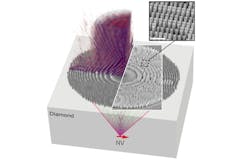Metasurface lens etched onto diamond single-photon quantum source efficiently collects photons
One of the most-important sources of entangled photons for research into quantum optical systems is the nitrogen-vacancy (NV) diamond, because entangled photons—and qubits, the units of quantum information necessary for quantum computing—can be created by diamonds at room temperature (other entangled photon sources typically need to be cryogenically cooled). In a nitrogen vacancy, one of the diamond's carbon atoms has bee replaced by a nitrogen atom, creating a defect that can absorb or emit light.
The practical challenge of collecting information from a single atom deep inside a diamond is a daunting one, however. Engineers at the University of Pennsylvania's School of Engineering and Applied Science (Penn Engineering; Philadelphia, PA) have addressed this problem by etching a metalens onto the surface of the diamond, making it easier to collect light from the defects inside—eliminating the need for the bulky microscope ordinarily needed to collect photons from a diamond.1
The researchers' 30-μm-diameter metalens consists of a field of pillars, each 1 μm tall and 100 to 250 nm in diameter, arranged in such a way that they focus light like a traditional refractive lens. Etched onto the surface of the diamond and aligned with one of the NV centers inside, the metalens focuses the emitted photons directly into an optical fiber, streamlining the data-collection process.
Immersion metalens
Because the metalens is an immersion lens (with diamond surrounding the source rather than air), it has a collection numerical aperture (NA) of greater than 1, greatly aiding the collection process. With improvements, the metalens' current NA of about 1.1 could potentially be boosted to near the theoretical maximum of about 2.4, say the researchers.
"We decided to collimate the light from NV centers to go to an optical fiber, as it readily interfaces with other techniques that have been developed for compact fiber-optic technologies over the past decade," says Tzu-Yung Huang, one of the researchers. "The compatibility with other photonic structures is also important. There might be other structures that you want to put on the diamond, and our metalens doesn’t preclude those other optical enhancements."
Source: https://medium.com/penn-engineering/penn-engineers-design-nanostructured-diamond-metalens-for-compact-quantum-technologies-271adddf69ba?sk=2d704064cc70d0d900ebfcf46c03a6ab
REFERENCE:
1. Tzu-Yung Huang et al., "A monolithic immersion metalens for imaging
solid-state quantum emitters," Nature Communications (2019); https://doi.org/10.1038/s41467-019-10238-5. This article is open and thus freely available.

John Wallace | Senior Technical Editor (1998-2022)
John Wallace was with Laser Focus World for nearly 25 years, retiring in late June 2022. He obtained a bachelor's degree in mechanical engineering and physics at Rutgers University and a master's in optical engineering at the University of Rochester. Before becoming an editor, John worked as an engineer at RCA, Exxon, Eastman Kodak, and GCA Corporation.
